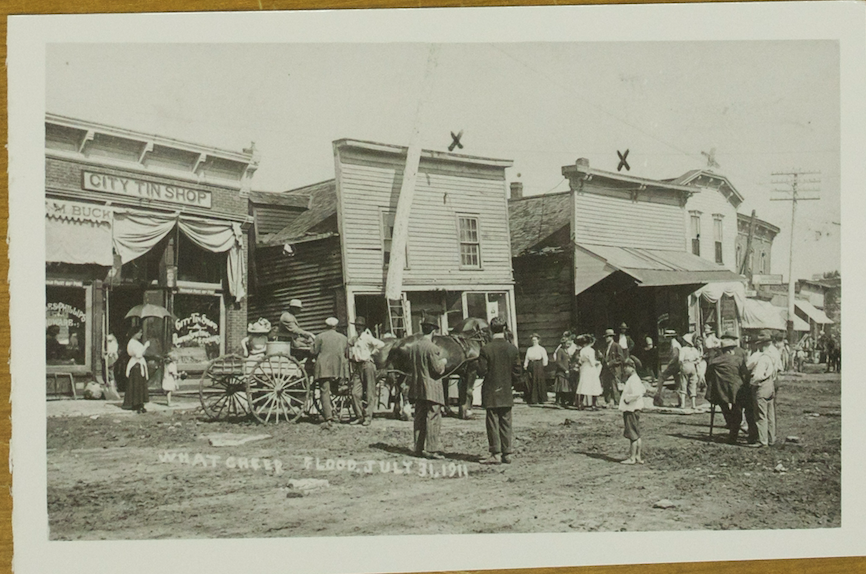The Creek that Moved Buildings
What Cheer
The 1911 photograph of downtown What Cheer labeled “Flood, July 31, 1911” seems, at first, to be mislabeled. Where is the flood? But wait. What are those x’s above the buildings telling us? These are buildings that had been moved off their foundations by an extraordinarily powerful flash flood in Coal Creek.

The summer of 1911 was not a wet one in the region. Drought conditions prevailed from May 1 through the end of July in nearby Missouri. At the city of Dubuque, to the north, the Mississippi River had been steadily falling through the summer and into the first half of July when its decline slowed but did not stop. Coal Creek had been dry through most of the summer.
It seems likely that residents of Keokuk County did not have flooding on their minds. But on the afternoon of July 31 a torrential rainstorm near What Cheer changed that. An article the next day in the Des Moines Evening Tribune provides a detailed description of what happened. Below is an excerpt.
“What Cheer, Iowa, August 1—Without warning a wall of water swept down Coal Creek last night, killing cattle, moving buildings, ruining crops and destroying bridges, causing a total loss of between $25,000 and $30,000. A heavy rain fell here all the afternoon, but at Tilton, 7 miles north of here, the precipitation was immense. Coal Creek, usually a dry stream, was soon filled and quickly spread beyond the banks, and [What Cheer’s] Main Street became a river almost in a second. Five feet of water flowed into the stores, stocks of goods were ruined, and clerks and storekeepers were forced to abandon the establishments. The sudden rise of Coal Creek began at 6 o’clock in the evening and continued until midnight. Many people became alarmed for the safety of their lives, but shortly after 12 o’clock the water began to subside, and this morning the creek is again within its banks. No damage was done by the water at Tilton, which is a coal camp….[But in What Cheer] the business section was demoralized, 5 buildings being moved from their foundations and others received damage. Five feet of water stood in many of the business[es and] houses. A 30,000-gallon tank in the Standard Oil Co.’s yards was toppled over and the entire contents lost. No fatalities were reported, although cattle in great numbers were killed in the flood. The wall of water came almost without warning, and farmers were unable to rescue their stock. Crops are damaged badly. Coal Creek has been dry since early in the summer, but at points last night it was nearly a mile wide. It flows into the South Skunk River.”
Source: SHSI: Disasters-Natural-Floods photographs; on-line: Monthly Weather Review, 39.2, US Department of Agriculture, Weather Bureau, Washington, D.C., 1911-1912.
